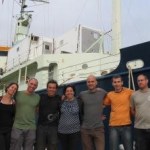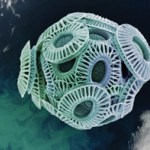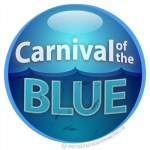Marine Biology
One day in the future, we may be treating our ailments with microbiotic combinations designed specifically to correct imbalances in our personal microbiomes. We’ll bring our prescriptions on rewritable paper and pay using shimmery optical chips embedded in our cell phone cases or maybe our jewelry. Or we’ll be waiting in our doctor’s office for a simple test of our microbiogenome to see if a light-based nanoparticle delivery treatment is working, while watching iridescent optical displays that change as we move...
These future scenarios (and many more) are all imaginary, but…
Today’s new articles involve flow: the flow of positrons through the Universe and the flow of particles around the tiny cilia of corals. They involve beauty and mystery, as well. The particle flow, imaged in brilliant colors, won first place in the photography category of the 2013 Science/National Science Foundation International Science & Engineering Visualization Challenge.
And positrons – the anti-matter opposites of electrons – have been found in large numbers flowing in near-Earth space. Weizmann Institute research points to an answer to one riddle: Why did a satellite…
One of our scientists, Dr. Assaf Vardi, is off on a month-long cruise. He is on the Knorr, a research vessel operated by the Woods Hole Oceanographic Institute, with a team from the Weizmann Institute and another four research teams on a route that will take them from the Azores to Iceland. On the way, they will be sampling the plankton; among other things they want to understand how the molecular processes that take place in these single-celled organisms affect everything from the ocean's food chain to the oxygen in the atmosphere. Rose Eveleth is posting from the ship daily on the…
Some of the best moments in my job as a Weizmann science writer are the times when a scientist I'm interviewing slips in a finding that shifts my understanding of how the world works. Not long ago, for instance, I was speaking with a researcher about his work on phytoplankton. Now, the fact that phytoplankton release about half of all the free oxygen on the planet should be an eye-opener to anyone, and a reminder of the importance of ocean health. (But that wasn't the surprise.)
Dr. Assaf Vardi researches the chemicals that phytoplankton produce to communicate. Of course, all sorts of…
So, you may have heard this rumor that I, on occasion, do things other than blog, tweet, or facebook. It may seem shocking, but I do have a day job (if you can call it that - a graduate student's job never seems to be restricted by sunlight).
For the past couple weeks, I've been getting my butt kicked into super shape by an intense 2-week scientific diver certification course, which covers from open water to master scuba diver at warp speed. It was intense, physically exhausting, and mentally draining. But it was well worth it, because now, I can do something even more intense, physically…
tags: Close Encounter with a Whale Shark in the Gulf of Mexico, marine biology, field research, research, technology, whale shark, Rhincodon typus, satellite tags, Gulf of Mexico, BP, Gulf Coast Research Laboratory, University of Southern Mississippi, streaming video
Whale Shark, Rhincodon typus, feeding in the Gulf of Mexico.
Image: Gulf Coast Research Laboratory Whale Shark Research.
Despite being the largest fish species in the world, measuring over 40 feet in length and 35 tons in weight, whale sharks are quite mysterious. We know they are plankton filter feeders, and we recently…
The nearly complete skeleton of a Steller's sea cow (Hydrodamalis gigas) - it is missing bones from the wrist and hand. From Woodward, 1885.
It did not take long for the last remaining population of Steller's sea cow to be driven into extinction. Discovered by the German naturalist Georg Steller around the Bering Sea's Commander Islands in 1741, this enormous and peculiar sirenian became an easy target for Russian hunters. By 1768, it was gone. (The marine mammal would not be scientifically described until 1780, and today it is formally known as Hydrodamalis gigas.) Yet, despite the clear…
A restoration of the tiny trilobite Ctenopyge ceciliae. From Schoenemann et al, 2010.
The first time I can remember seeing a trilobite, it wasn't in a museum case or a book about prehistoric animals. It was on card 39 of the gratuitously gory Dinosaurs Attack! card series, a horrific vignette depicting four of the invertebrates crawling over the bloodied face of their hapless victim. (No indication was given as to how the "flesh-eating worms", as the card identified them, had subdued the man.) The card was entirely fiction, of course, but it still fit in with the image of trilobites as mud…
tags: Drop into the Ocean, Greenpeace, documentary, whaling, overfishing, fish farming, mining, oil drilling, climate change, underwater marine parks, endangered species, conservation, marine biology, streaming video
Take a deep breath and imagine the oceans.... This disturbing video is a short Greenpeace documentary outlining the threats that humans pose to our oceans and a proposal for what we ALL can do to help restore their health. [In short, if you haven't stopped eating all fish -- and most especially shrimp -- yet, this video will make you think seriously about this decision]
The skull of Mosasaurus hoffmani. From Lingham-Soliar 1995.
On my first trip to the Inversand marl pit in Sewell, New Jersey, I didn't find the wonderfully preserved Dryptosaurus skeleton I had been dreaming of. I picked up a number of Cretaceous bivalve shells and Paleocene sponges, but other than a few scraps of "Chunkosaurus" my excavations didn't yield very much. Before my paleontology class left the site, though, we took a walk by the spoil piles - great green mounds of sediment that had already been mined for glauconite. It had recently rained, and little pillars of the sandy green…
tags: ecology, marine biology, conservation biology, endangered species, habitat preferences, Northern Bluefin Tuna, Atlantic Bluefin Tuna, Thunnus thynnus, Yellowfin Tuna, Thunnus albacares, fisheries, PLoS ONE, researchblogging.org,peer-reviewed research, journal club
An adult Atlantic (Northern) Bluefin Tuna, Thunnus thynnus.
A recently published study, intended to provide data to commercial fisheries in the Gulf of Mexico so they maximize their catch of Yellowfin Tuna, Thunnus albacares, whilst avoiding bycatch of critically endangered Atlantic (Northern) Bluefin Tuna, Thunnus thynnus…
tags: Care for Some Crude With Your Sushi?, toro sushi, maguro sushi, Atlantic Bluefin Tuna, Thunnus thynnus, Gulf of Mexico, pollution, oil spill, Deepwater Horizon, BP, British Petroleum, overfishing, endangered species, conservation, marine biology, streaming video
The Gulf of Mexico oil spill is the worst environmental disaster the US has faced. Toxic oil from the Deepwater Horizon well threatens the region's sensitive shorelines and the nesting birds along the Louisiana coast. But there's another species at serious risk: the Atlantic bluefin tuna, Thunnus thynnus. This disturbing video…
tags: ecology, marine biology, conservation biology, endangered species, environmental toxicology, seabirds, marine mammals, researchblogging.org,peer-reviewed research, journal club
Bird rescue personnel Danene Birtell (L) and Heather Nevill (R) hold an oiled brown pelican, found on Storm Island in the Gulf of Mexico off the coast of Louisiana, that will be washed at the treatment facility at Fort Jackson, Louisiana, USA. BP has contracted bird rescue groups to rehabilitate wildlife affected by the Deepwater Horizon oil spill. The birds are examined, thoroughly washed and then allowed to…
The "common cuttle-fish." From Mysteries of the Ocean.
About three decades before On the Origin of Species by Means of Natural Selection would forever change biological science, the aspiring young naturalists Pierre-Stanislas Meyranx and Laurencet submitted a paper on mollusks to France's prestigious Academie des Sciences. For weeks they waited for a patron from within the scientific elite to recognize their work, but no response came. Ultimately they decided to take the more direct route of having the paper examined by a commission, and in 1830 the naturalists Pierre-Andre Latreille and…
tags: Brian Skerry Reveals Ocean's Glory -- and Horror, conservation, marine biology, fish, marine mammals, oceans, sharks, leatherback sea turtle, right whale, overfishing, photographer, Brian Skerry, TEDTalks, TED Talks, streaming video
Professional photographer Brian Skerry shoots life above and below the waves -- as he puts it, both the horror and the magic of the ocean. Sharing amazing, intimate shots of undersea creatures, he shows how powerful images can help make change.
TEDTalks is a daily video podcast of the best talks and performances from the TED Conference, where the world's…
If for no other reason, I love the American Museum of Natural History because it contains a web of seemingly endless nooks and crannies to explore. One, just far enough away from the main exhibit halls to go unnoticed by most visitors (it is not even denoted on the museum map anymore), is a collection of seashells from a time when neatly-arrayed collections of specimens set in place next to their identification labels formed the core of natural history museums. Most are relatively familiar, curled houses without their occupants, but there is one which immediately grabbed my attention the…
The tail of a thresher shark (Alopias vulpinus). From Wikipedia.
Thanks to sensational documentaries and summer blockbusters, we are all familiar with the anatomy of a shark attack. The victim, unaware that they are in peril, is struck from below and behind with such speed and violence that, if they are not actually killed during the first strike, they soon find themselves a few pounds lighter in the middle of a billowing red cloud. The trouble is that this stereotyped scenario does not hold for all sharks, particularly one peculiar group of deepwater sharks which has long puzzled…
Components of the newly-described Fezouata fauna. a, Demosponge Pirania auraeum b, Choiid demosponge c, Annelid worm d, Organism showing possible similarities to halkieriids e, Possible armoured lobopod f, Thelxiope-like arthropod g, Marrellomorph arthropod, probably belonging to the genus Furca h, Skaniid arthropod i, Spinose arthropod appendage
apparatus consisting of six overlapping elements. From Van Roy et al, 2010.
When the Cambrian period comes up in conversation, it is usually in reference to the evolutionary "explosion" which occurred around 530 million years ago. Animal fossils…
The jaws of C. megalodon as restored by Bashford Dean for the AMNH in 1909. Image from the American Museum Journal.
My early elementary reading school choices often got me into trouble. Every week I would pass over the recommended, grade-appropriate sections for the few shelves containing the books about dinosaurs, sharks, and alligators - if it was big and hard sharp teeth, I wanted to learn about it. The school librarian was not too pleased with this, even calling my parents in on one occasion to insist that I read something fit for younger children, but I just could not get enough of…
Ahoy mates, and welcome aboard the 36th edition of the Carnival of the Blue!
The Oceans as a whole:
As many of you might know, CITES had its once-every-three-years meeting during which it decides which organisms are to be regulated and how. As Rick MacPherson explains, the overall message was simple: FU, Ocean. He takes a closer look at the CITES listing process and digs a little deeper into the "secret ballots."
Maybe CITES will take note if the world made it clear that oceans matter. There's no better time than now to take Oceana's Ocean Pledge. If you do, $1 will be donated to Oceana to…




